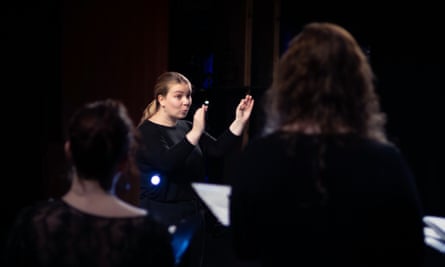I’ve lost track of the number of times I’ve been asked my thoughts on the film Tár these last few weeks. It seems as if everyone wants to know what it’s really like to be a woman in conducting, and how I feel about the abusive fictional character causing a stir on cinema screens across the globe.
Lydia Tár lives in a world that closely resembles present-day reality, complete with references to a recent pandemic. But one notable difference is apparent: in Tár’s world, female conductors have well and truly smashed the glass ceiling, and conducting seems to be a gender-balanced profession. In the film’s opening scenes, Tár talks about how the challenges once faced by women are in the past, and suggests that her fellowship programme for female conductors should be opened up to men as it no longer feels necessary to distinguish between genders.
This strikes me as a strange utopian fantasy. In the real world, it’s no secret that conducting has a gender problem. According to recent figures from the Royal Philharmonic Society, there are currently only five female conductors with titled roles amid the several hundred conductors on the staff of professional British orchestras, and only 11% of conductors signed by British agents are women.
Things are slowly improving, but as a woman in this field, I still feel like an outlier. I’m currently the only female student on the postgraduate choral conducting course at the Royal Academy of Music, and throughout my musical education, my conducting teachers have been only men.
I’m very fortunate to have learned from some of the best in the business, at inspiring institutions that have provided me with opportunities to excel. But there have been individuals along the way who have commented on my gender. I’ve been told that my conducting is “always just too girly”, that I need to conduct “with more testosterone”, and that “it’s harder for women to show a true forte”.
Such comments might be intended to be constructive, but I find it difficult to respond. No matter how I conduct, I’m always going to look like a woman. In all honesty, I’m still grappling with what it means to be both feminine and a conductor. Historically speaking, conducting is a man’s world: a profession that was created and defined by men. And until recently, the greatest world-famous maestros have all been male, leading many to hold a deep-rooted (often subconscious) view that excellent conducting looks masculine.
I would have loved to see Tár challenge that ideal – an ultra-successful celebrity conductor who also happens to look, dare I say it, girly. But even in her seemingly gender-balanced world, in many ways Lydia Tár perpetuates the masculine conductor trope: she wears tailored power suits; speaks in a low voice; drives fast cars; abuses her position of power.
About 10 years ago, conductor Vasily Petrenko gave a now-infamous interview in which he claimed that orchestras “react better when they have a man in front of them” and that “a cute girl on a podium means that musicians think about other things”. I wish attitudes like that were a distant memory, but I’ve heard similar comments, and know female colleagues who have been advised to be careful about what they wear to conduct, in case it sends the wrong message.

Sometimes, though, being careful still isn’t enough. Recently, I conducted a concert in a long-sleeved, full-length, loose-fitting dress – not that it should matter what I was wearing – and afterwards was approached by an older audience member, who told me that he liked watching my bum wiggle as I conducted.
I’m starting to accept that no matter how much I want it to be all about the music, for some my presence on the podium is still a novelty. I’m hopeful that Tár will help to change that. It has been refreshing to see images of a woman conducting on billboards and online advertisements across the world. But, to state the obvious: we must not forget that she’s fictional. Berlin has never had a female principal conductor; there are no female conductor-composer EGOT winners.
And if Lydia Tár is the only representation of a female conductor we see in the mainstream media, we have a problem. When it comes to encouraging more women to pick up the baton, the importance of excellent, real-life role models cannot be overstated. When I was a child attending a local state school in rural Herefordshire, classical music seemed to be worlds away from my everyday life. The idea of becoming a musician – let alone a conductor – felt impossible. My “lightbulb moment” came while working with Mirga Gražinytė-Tyla, as a member of the City of Birmingham Symphony Orchestra’s Youth Chorus. She had recently been appointed music director of the orchestra – the first woman to hold the role, and the only woman at the time to be principal conductor of a major UK orchestra. Watching her lead the rehearsal, I was struck by her kind, gentle, yet firm and self-assured manner. I had a revelation: this was a job that someone like me could do.
I still today meet people who have never come across a female conductor before. Some are confused about how to describe me – I’ve heard conductress, maestra, chorus mistress. Tár has helped to increase visibility of women in conducting, and hopefully one day I will no longer need to explain myself, and my presence on the podium won’t be remarked on. But until then, let’s continue giving women opportunities to break into the highest levels of the music industry; to challenge misconceptions; and to inspire the next generation of conductors.

